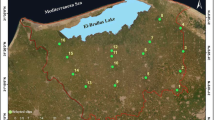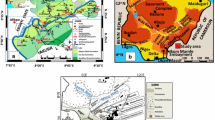Abstract
The present paper summarizes previous studies on the characteristics and soil properties of Red Sea water and how it is impacting civil engineering infrastructures; the review also looks at various geotechnical parameters. Seawater may have negative effects on soil as well as on infrastructures such as airports, seaports, highways, and buildings. The average value of salinity (psu) is 40.60 ± 0.10 with significant positive or negative differences among years, months, and depths. However, along the northern coast of the Red Sea, turbidity is in the range of 1 to 3 Formazin Nephelometric Units (FNU). Moreover, while surface average pH is 8.1 ± 0.02 during winter, higher values occur in the north due to lower temperatures. Similarly, during the summer, average Red Sea surface pH is 8.07 ± 0.03, with higher values occurring in the north due to temperature differences. The water pH at Gulf of Aqaba fluctuates around 8.3. The mean value of Red Sea temperature is 27.88 ± 2.14 °C. The average value of dissolved oxygen is 6.77 ± 0.41 mg/L. During the present work, the geotechnical parameters are investigated. In general, salts decrease the plasticity index, soil compressibility, swelling characteristics, and optimum moisture content while increasing the permeability, maximum dry density, shear strength, and bearing capacity of soil.










Similar content being viewed by others
References
Abu-Hilal AH, Badran MM (1990) Effect of pollution sources on metal concentration in sediment cores from the Gulf of Aqaba (red sea). Mar Pollut Bull 21:190–197
Ajalloeian R, Mansouri H, Sadeghpour AH (2013) Effect of saline water on geotechnical properties of fine-grained soil. Electronic Journal of Geotechnical Engineering (EJGE) 18(G):1419–1435
Al-Amoudi OSB (2002) Characterization and chemical stabilization of Al-Qurayyah sabkha soil. J Mater Civ Eng 14:478–484
Al-Amoudi, O.S.B., 2008. Testing and stabilization of saline sabkha soils: a review. On Case Histories in Geaotechnical Engineering, Arlington, Virginia
Al-Amoudi OSB, Abduljauwad SN, El-Naggar ZR, Rasheeduzzafar (1992) Response of sabkha to laboratory tests: a case study. Eng Geol 33:111–125
Ali KM, Malik I (2015) Geotechnical properties of Sabkha soil in the southern part of AlKhobar city, KSA. Int J Eng Res Appl 5:24–29
Al-Mhaidib, A.I., 2003. Sabkha soil in the Kingdom of Saudi Arabia: characteristics and treatment. Arts and Humanities 14
Al-Rawas AA, Taha R, Nelson JB, Belt Al-Shab T, AL-Siyabi H (2002) A comparative evaluation of various additives used in the stabilization of expansive soils. Geotech Test J 25(2):199–209
Al-Sanad H, Ismael N, Nayfeh A (1993) Geotechnical properties of dune sands in Kuwait. Eng Geol 34:45–52
Amu OO, Salami BA (2010) Effect of common salt on some engineering properties of eggshell stabilized lateritic soil. ARPN Journal of Engineering and Applied Sciences 5(9):64–73
Ann KY, Song H-W(2007) Chloride threshold level for corrosion of steel in concrete. Corros Sci 49:4113–4133
Arasan S, Yetimoglu T (2008) Effect of inorganic salt solutions on the consistency limits of two clays. Turk J Eng Environ Sci 32:107–115
Bdour, A., Tarawneh, Z., ALMOMANI, T., 2015. Real-time remote monitoring (RTRM) of selected water quality parameters in marine ecosystem using wireless sensor networks. Proc. 14th Int. Conf. Environ. Sci. Technol., pp. 3–5
Bulleri F, Chapman MG (2010) The introduction of coastal infrastructure as a driver of change in marine environments. J Appl Ecol 47:26–35
Chaidez V, Dreano D, Agusti S, Duarte CM, Hoteit I (2017) Decadal trends in Red Sea maximum surface temperature. Sci Rep 7:8144–8144
Durotoye TO, Akinmusuru JO, Ogbiye AS, Bamigboye GO (2016) Effect of common salt on the engineering properties of expansive soil. International Journal of Engineering and Technology(IJET) -Volume 6(7):233–241
Elmashad ME, Ata AA (2016) Effect of seawater on consistency, infiltration rate and swelling characteristics of montmorillonite clay. HBRC Journal 12:175–180
Farag, A.A., 2019. The story of NEOM city: opportunities and challenges. New Cities and Community Extensions in Egypt and the Middle East. Springer, pp. 35-49
Gorakhki, Mohammad R. H. and Bareither, Christopher A., 2016. Effects of Salinity on the geotechnical characterization of fine-grained soils and mine tailings,” Geotech Test J, Vol. 39(1):1–14, doi:https://doi.org/10.1520/GTJ20140283. ISSN 0149-6115
Hansson CM, Frølund T, Markussen JB (1985) The effect of chloride cation type on the corposion of steel in concrete by chloride salts. Cem Concr Res 15:65–73
Helle TE, Nordal S, Aagaard P, Lied OK (2015)Long-term effect of potassium chloride treatment on improving the soil behavior of highly sensitive clay—Ulvensplitten, Norway. Can Geotech J 53(3):410–422
Ismael NF (1993) Laboratory and field leaching tests on coastal salt-bearing soils. J Geotech Eng 119:453–470
Khalaf, M.A., Kochzius, M., 2002. Changes in trophic community structure of shore fishes at an industrial site in the Gulf of Aqaba, Red Sea. Marine Ecology Progress Series, pp. 287-299
Kumar S, Kameswara Rao CVS (1994) Effect of sulfates on the setting time of cement and strength of concrete. Cem Concr Res 24:1237–1244
Mahasneh, B. Z., 2004. Dead Sea water as a soil improvement agent. ElectronicJournal of Geotechnical Engineering, 9
Manasrah, R., Raheed, M., Badran, M.I., 2006. Relationships between water temperature, nutrients and dissolved oxygen in the northern Gulf of Aqaba, Red Sea. Oceanologia 48
Manasrah, R., Abu-Hilal, A., Rasheed, M., 2019. Physical and chemical properties of seawater in the Gulf of Aqaba and Red Sea. Oceanographic and biological aspects of the Red Sea. Springer, pp. 41-73
Manasrah R, Alsaad L, Trabeen K, Rasheed M, Al-Absi E, Dixon LK, Al-Sawalmih A (2020) Physical and chemical properties of seawater during 2013-2015 in the 400 m water column in the northern Gulf of Aqaba, Red Sea. Environ Monit Assess 192:1–16
Mansour ZM, Taha MR, Chik Z (2008) Fresh-brine water effect on the basic engineering properties of Lisan Marl-Dead Sea-Jordan. J Appl Sci 8:3603–3611
Mansouri H, Jorkesh Z, Ajalloeian A, Sadeghpour AH (2017) Investigating effects of water salinity on geotechnical properties of fine-grained soil and quartz in a sandstone case study: Ajichay project in northwest Iran. Bull Eng Geol Environ 76:1117–1128. https://doi.org/10.1007/s10064-016-0920-4
Messad, A., Debbab, O.Y., Moussai, B., 2017. Effect of water salinity on the compaction of sabkha soils. 2nd International Conference "Challenges in Geotechnical Engineering, Ukraine
Mezger EM, Nooijer LJ, Boer W, Brummer GJA, Reichart GJ (2016) Salinity controls on Na incorporation in Red Sea planktonic foraminifera. Paleoceanography 31:1562–1582
Morcillo M (1999) Soluble salts: their effect on premature degradation of anticorrosive paints. Progress in Organic Coatings 36:137–147
Otoko R (2014) The effect of salt water on the physical properties, compaction characteristics and unconfined compressive strength of a clay, clayey sand and base course. European International Journal of Science and Technology 3(2):9–16
Prakhar D, Rajesh J (2015) Effect of common salt (NaCl) on engineering properties of black cotton soil. International Journal of Science Technology and Engineering 2(1):64–68
Ramadas TL, Kumar ND, Yesuratnam G (2012) A study on strength and swelling characteristics of three expansive soils treated with CaCl2. International Journal of Advances in Civil Engineering and Architecture. Vol 1(1):77–86
Shaltout M (2019) Recent sea surface temperature trends and future scenarios for the Red Sea. Oceanologia 61:484–504
Shariatmadari N, Salami M, KarimpourFard M (2011) Effect of inorganic salt solutions on some geotechnical properties of soil-bentonite mixtures as barriers. International Journal of Civil Engineering 9(2):103–110
Sivapullaiah PV, Manju (2005) Kaolinite-alkali interaction and effects on basic properties. Geotechnical and GeologicalEngineering 23:601–614
Sofianos SS, Johns WE (2007) Observations of the summer Red Sea circulation Journal of Geophysical Research: Oceans 112
Stern RT, Shackelford CD (1998) Permeation of sand-processed clay mixtures with calcium chloride solutions. Journal of Geotechnical and Geo-environmental Eng ASCE 124(3):231–241
Stipho A (1985) On the engineering properties of salina soil. Q J Eng Geol Hydrogeol 18:129–137
Taha A, Fall M (2014) Shear behavior of sensitive marine clay–steel interfaces. Acta Geotech 9:969–980. https://doi.org/10.1007/s11440-014-0321-4
Yilmaz G, Yetimoglu T, Arasan S (2008) Hydraulic conductivity of compacted clay liners permeated with inorganic salt solutions. Waste Manag Res 26(5):464–473
Yong, R.N., Mohamed, A.M.O. and Warkentin, B.P., 1992. Principles of contaminant transport in soils. Developments in Geotechnical Engineering, vol. 73, Elsevier Science Publishers,Amsterdam
Youssef M (2015) Heavy metals contamination and distribution of benthic foraminifera from the Red Sea coastal area, Jeddah, Saudi Arabia. Oceanologia 57:236–250
Yukselen-Aksoy Y, Kaya A, Ören AH (2008) Seawater effect on consistency limits and compressibility characteristics of clays. EngineeringGeology 102:54–61
Zhang, O’Kelly (2013) Effect of salt grain additions on fibrous peat consolidation. Ground Improvement J. Proceedings of the Institution of Civil Engineers, ICE Publishing, https://doi.org/10.1680/grim.12.00034. Paper 1200034
Funding
This work was funded (S-1439-0207) by the University of Tabuk, Tabuk, Kingdom of Saudi Arabia. The authors thank specially the Deanship of scientific research at University of Tabuk.
Author information
Authors and Affiliations
Corresponding author
Additional information
Responsible Editor: Zeynal Abiddin Erguler
Rights and permissions
About this article
Cite this article
Elsawy, M.B.D., Lakhouit, A. A review on the impact of salinity on foundation soil of coastal infrastructures and its implications to north of Red Sea coastal constructions. Arab J Geosci 13, 555 (2020). https://doi.org/10.1007/s12517-020-05601-6
Received:
Accepted:
Published:
DOI: https://doi.org/10.1007/s12517-020-05601-6




